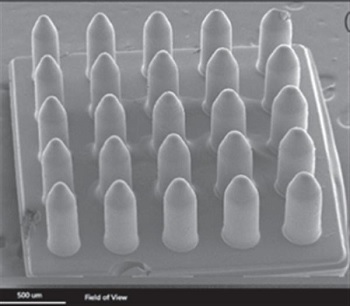 |
| Microneedle array--Courtesy of U. of Akron and U. of Texas |
Microneedle patches have long been seen as a potential alternative to needles to treat, for instance, diabetes, eye conditions or cancer. Producing the tiny needles, though, is difficult and costly. But a team of scientists from the University of Akron and the University of Texas has now developed a technique for manufacturing the transdermal arrays using a process called microstereolithography.
The researchers delivered the skin cancer chemotherapy dacarbazine using a 25-needle array of polymer microneedles. What's unique about these needles is that they don't actually hold the drug within a hollow cavity, but the drug is blended uniformly into the polymer, which degrades at a controlled rate for 5 weeks, according to the study, which was published in the journal Biofabrication.
The scientists assert that the drug-loaded array has potential in the treatment of skin carcinomas.
"3D printing this array was difficult, as the printable biomaterial contains some non-printable solvents and drugs," lead author Jae-Won Choi said in a statement. "We'd like to have a faster drug release, but this will require more material research. Once we improve this process we can look at developing more controlled drug release. I'd hope we'll see this being used clinically in 5-10 years."
- here's the release
- and the Biofabrication study